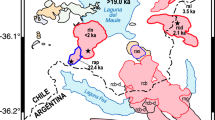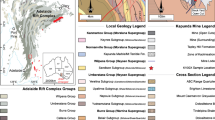Abstract
Tanna island is part of a large volcanic complex mainly subsided below sea-level. On-land, two series of hydroclastic deposits and ignimbrites overlie the subaerial remains of a basal, mainly effusive volcano. The ‘Older’ Tanna Ignimbrite series (OTI), Late Pliocene or Pleistocene in age, consists of ash flows and ash- and scoria-flow deposits associated with fallout tephra layers, overlain by indurated pumice-flow deposits. Phreatomagmatic features are a constant characteristic of these tuffs. The ‘younger’ Late Pleistocene pyroclastics, the Siwi sequence, show basal phreatomagmatic deposits overlain by two successive flow units, each comprising a densely welded layer and a nonwelded ash-flow deposit. Whole-rock analyses of 17 juvenile clasts from the two sequences (vitric blocks from the phreatomagmatic deposits, welded blocks, scoriaceous bombs and pumices from the ignimbrites) show basaltic andesite and andesite compositions (SiO2=53–60%). In addition, 296 microprobe analyses of glasses in these clasts show a wide compositional range from 51 to 69% SiO2. Dominant compositions at ∼54, 56, 58.5 and 61–62% SiO2 characterize the glass from the OTI. Glass compositions in the lower — phreatomagmatic — deposits from the Siwi sequence also show multimodal distribution, with peaks at SiO2=55, 57.5, 61–62 and 64% whereas the upper ignimbrite has a predominant composition at 61–62% SiO2. In both cases, mineralogical data and crystal fractionation models suggest that these compositions represent the magmatic signature of a voluminous layered chamber, the compositional gradient of which is the result of fractional crystallization. During two major eruptive stages, probably related to two caldera collapses, the OTI and Siwi ignimbrites represent large outpourings from these magmatic reservoirs. The successive eruptive dynamics, from phreatomagmatic to Plinian, emphasize the role of water in initiating the eruptions, without which the mafic and intermediate magmas probably would not have erupted.
Similar content being viewed by others
References
Bice DC (1985) Quaternary volcanic stratigraphy of Managua, Nicaragua: correlation and source assignment for multiple overlapping plinian deposits. Geol Soc Am Bull 96:553–566
Carney JN, McFarlane A (1979) Geology of Tanna, Anneytum, Futuna and Aniwa. New Hebrides Geol Surv Reg Rep, Port Vila, 79 pp
Carr MJ (1991) Igpet Mac program. Terra Softa Inc, Somerset, NJ, USA
Cas RAF, Wright JV (1987) Volcanic successions: modern and ancient. A geological approach to processes, products and successions. Allen & Unwin, London, 528 pp
Coulon C, Maury RC (1981) Petrology of Tholeiitic lavas from Tanna Island (New Hebrides): Importance of cumulative processes in Island Arc Magmatism. Bull Volcanol 44-4:662–680
Crawford AJ, Greene HG, Exon NF (1988) Geology, petrology and geochemistry of submarine volcanoes around Epi island, New Hebrides island arc. In: Greene HG and Wong FL (eds) Geology and offshore resources of Pacific island arcs-Vanuatu region. Circum-Pacific Council for Energy and Mineral Resources Earth Science Series 8, Houston, Texas: 301–327
Druitt TH, Sparks RSJ (1982) A proximal ignimbrite breccia facies on Santorini, Greece. J Volcanol Geotherm Res 13:147–171
Dugas F, Carney JN, Cassignol C, Jezek PA, Monzier M (1976) Dredged rocks along a cross-section in the Southern New Hebrides Island Arc and their bearing on the age of the arc. In: Geodynamics in South-West Pacific. Technip Ed., Paris: 105–116
Eggins SM (1989) The origin of primitive ocean island and island arc basalts. PhD thesis, University of Tasmania, 402 pp
Gardeweg M, Ramirez CF (1987) La Pacana caldera and the Atana Ignimbrite. A major ash-flow and resurgent complex in the Andes of northern Chile. Bull Volcanol 49:547–566
Gorton MP (1977) The geochemistry and origin of Quaternary in the New Hebrides. Geochim Cosmochim Acta 41:1257–1270
Heiken G, McCoy F (1984) Caldera development during the Minoan Eruptions. Thira, Cyclades, Greece. J Geophys Res 89:8441–8462
Lipman PW, Christiansen RL, O'Connor JT (1966) A compositionally zoned ash-flow sheet in southern Nevada. US Geol Surv Prof Pap 524-F:1–47
McFarlane A, Carney JN, Crawford AJ, Greene HG (1988) Vanuatu — A review of the onshore geology. In: Greene HG and Wong FL (eds) Geology and offshore resources of Pacific island arcs-Vanuatu region, Circum-Pacific Council for Energy and Mineral Resources Earth Science Series 8, Houston, Texas: 45–91
Monzier M, Robin C, Eissen JP, Picard C (1991) Découverte d'un large anneau de tufs basaltiques associé à la formation de la caldéra d'Ambrym (Vanuatu, SW Pacifique). Comptes Rendus Ac Sc Paris 2, 312:1319–1326
Nairn A, Scott BJ, Giggenbach WF (1988) Yasur volcano investigations, Vanuatu, Sept 1988. New Zealand Geol Surv Rep G 134:74 pp
Picard C, Monzier M, Eissen JP, Robin C (in press) Concomitant evolution of tectonic environment and magma geochemistry, Ambrym volcano (Vanuatu-New Hebrides arc). J Geol Soc London, sp issue of the meeting Volcanism associated with extension at consuming plate margins JL Smellie (ed)
Robin C, Monzier M, Eissen JP, Picard C, Camus G (1991) Coexistence de lignées HK and MK dans les pyroclastites associées à la caldéra d'Ambrym (Vanuatu, Arc Des Novuelles Hébrides). Comptes Rendus Ac Sc Paris 2, 313:1425–1432
Robin C, Eisen JP, Monzier M (1993) Giant tuff cone and 12 kmwide associated caldera at Ambrym volcano, New Hebrides Arc. J Volcanol Geotherm Res 55:225–238
Roca JL (1978) Contribution à l'étude pétrologique et structurale des Nouvelles Hébrides. Thesis Univ Sciences et Techniques du Languedoc, Montpellier 157 pp
Rocher P, Westercamp D (1989) The Salazie cirque ignimbrite (Piton des neiges Volcano, Reunion Island): Chronostratigraphy, description and signficance of lithic fragments and eruptive mechanisms. J Volcanol Geotherm Res 36:177–191
Rosi M, Sbrana A, Principe C (1983) The Phlegraean fields: structural evolution, volcanic history, and eruptive mechanisms. J Volcanol Geotherm Res 17:273–288
Schmincke HU (1976) Geology of the Canary islands. In: Kunkel G (ed) Biogeography and ecology in the Canary Islands. W Junk, The Hauge:67–184
Self S, Rampino MR, Carr MJ (1989) A reappraisal of the 1835 eruption of Cosigüina and its atmospheric impact. Bull Volcanol 52:57–65
Sigurdsson H, Carey S (1989) Plinian and co-ignimbrite tephra fall from the 1815 eruption of Tambora volcano. Bull Volcanol 51:243–270
Sparks RSJ, Walker GPL (1977) The significance of vitric air-fall ashes associated with crystal-enriched ignimbrites. J Volcanol Geotherm Res 2:329–341
Sparks RSJ, Wilson L (1976) A model for the formation of ignimbrite by gravitational column collapse. J Geol Soc London 132:441–451
Sparks RSJ, Self S, Walker GPL (1973) Products of ignimbrite eruption. Geology 1:115–118
Sparks RSJ, Sigurdsson H, Wilson L (1977) Magma mixing: a mechanism for triggering acid explosive eruptions. Nature 267:315–318
Taylor GA (1956) Review of the volcanic activity in the Territory of Papua-New Guinea, the Solomon and New Hebrides islands, 1951–1953. Bull Volcanol 18:25–37
Walker GPL (1985) Origin of coarse lithic breccias near ignimbrite source vents. J Volcanol Geotherm Res 25:157–171
Williams CE, Curtis R (1964) The eruption of Lopevi Volcano, New Hebrides, July 1960. Bull Volcanol 27:423–433
Williams CEF, Warden AJ (1964) Progress report of the Geological Survey for 1959–1962. New Hebrides Geol Surv Rep, Port Vila, New Hebrides, 75 pp
Williams H, McBirney AR (1979) Volcanology, Freeman, Cooper, San Francisco, 391 pp
Williams SN (1983) Plinian airfall deposits of basaltic composition. Geology 11:211–214
Wright JV, Walker GPL (1981) Eruption, transport and deposition of ignimbrite: a case study from Mexico. J Volcanol Geotherm Res 9:111–131
Author information
Authors and Affiliations
Rights and permissions
About this article
Cite this article
Robin, C., Eissen, JP. & Monzier, M. Ignimbrites of basaltic andesite and andesite compositions from Tanna, New Hebrides Arc. Bull Volcanol 56, 10–22 (1994). https://doi.org/10.1007/BF00279725
Received:
Accepted:
Issue Date:
DOI: https://doi.org/10.1007/BF00279725




